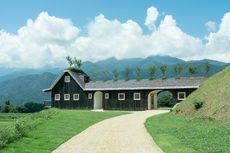Kengo Kuma’s hen house in Mexico rules the roost
The latest architectural addition to the Casa Wabi Foundation is a chicken coop like no other

Ample communal areas for socialising, outdoor space for everyone, and private quarters for rest and contemplation are all conditions that could easily define contemporary co-housing of the highest design quality; yet it was a different type of resident that Japanese architect Kengo Kuma and his team had in mind when they used the same principles on a recent project.
Built for the Casa Wabi Foundation, a non-profit art and community organisation based on Mexico’s Oaxacan Coast, this is a chicken coop like no other.

Working with a grid and lattice-type walls, the architects used the design to distribute structural loads across the building, keeping the aesthetic pure and simple. This modular approach helped define different types of spaces within, including sheltered areas for the general activities of the coop and individual cells for each of its inhabitants. The wood used is solid pine turned dark and patinated using the traditional Japanese yakisugi technique, and the hen house now provides eggs to feed Casa Wabi’s staff and artists in residence.
As originally featured in the December 2019 issue of Wallpaper* (W*249)
INFORMATION
Wallpaper* Newsletter
Receive our daily digest of inspiration, escapism and design stories from around the world direct to your inbox
Ellie Stathaki is the Architecture Editor at Wallpaper*. She trained as an architect at the Aristotle University of Thessaloniki in Greece and studied architectural history at the Bartlett in London. Now an established journalist, she has been a member of the Wallpaper* team since 2006, visiting buildings across the globe and interviewing leading architects such as Tadao Ando and Rem Koolhaas. Ellie has also taken part in judging panels, moderated events, curated shows and contributed in books, such as The Contemporary House (Thames & Hudson, 2018) and Glenn Sestig Architecture Diary (2020).
-
 Orchid Pavilion channels Japanese philosophy for blossoming flowers in Puerto Escondido
Orchid Pavilion channels Japanese philosophy for blossoming flowers in Puerto EscondidoOrchid Pavilion by CCA Centro de Colaboración Arquitectónica provides fitting shelter for flower conservation in Mexico's Casa Wabi
By Ellie Stathaki Published
-
 Chef Raphael Rego’s Oka Fogo in Paris is two Brazilian restaurants in one
Chef Raphael Rego’s Oka Fogo in Paris is two Brazilian restaurants in oneOka Fogo in Paris, by Michelin-starred chef Raphael Rego, offers two dining spaces, with interiors by Arnaud Behzad and joyful frescoes by Florence Bamberger
By Sofia de la Cruz Published
-
 ‘Fungi: Web of Life’ film sees Björk and Merlin Sheldrake explore a magical world
‘Fungi: Web of Life’ film sees Björk and Merlin Sheldrake explore a magical worldBjörk and microbiologist Merlin Sheldrake unite for ‘Fungi: Web of Life’, a 3D film in which the beauty and ecological importance of fungi unfurls
By Amah-Rose Abrams Published
-
 Nekoyacho Bldg is a Hiroshima office on a crossroads of 'food, work and entertainment'
Nekoyacho Bldg is a Hiroshima office on a crossroads of 'food, work and entertainment'Nekoyacho Bldg has been designed by Suppose Design Office as a 21st century workspace in Hiroshima, Japan
By Danielle Demetriou Published
-
 Heatherwick Studio’s Azabudai Hills district launches as Tokyo’s newest city-in-a-city
Heatherwick Studio’s Azabudai Hills district launches as Tokyo’s newest city-in-a-cityTokyo welcomes the Azabudai Hills district, designed by Heatherwick Studio and constructed as a city-in-a-city after over three decades of planning
By Danielle Demetriou Published
-
 Toranomon Hills Station by OMA adds dynamism to the Tokyo skyline
Toranomon Hills Station by OMA adds dynamism to the Tokyo skylineToranomon Hills Station is OMA's first tower in Tokyo - as well as a project expanding and evolving the high rise typology
By Danielle Demetriou Published
-
 Terunobu Fujimori’s Kodomari Fuji guest house features a roof lined with cherry trees
Terunobu Fujimori’s Kodomari Fuji guest house features a roof lined with cherry treesCherry trees line the roof at Kodomari Fuji, Terunobu Fujimori's first accommodation facility design, a private guest house in Japan
By Joanna Kawecki Published
-
 Modern Japanese houses inspiring minimalism and avant-garde living
Modern Japanese houses inspiring minimalism and avant-garde livingWe tour the best Japanese architecture and modern Japanese houses designed by international and local architects that open up possibilities for all types of lifestyle, from minimalist to communal in Japanese architecture.
By Ellie Stathaki Published
-
 Arii Irie, Japan: Wallpaper* Architects’ Directory 2023
Arii Irie, Japan: Wallpaper* Architects’ Directory 2023Japanese practice Arii Irie has joined the Wallpaper* Architects’ Directory 2023, our annual round-up of exciting emerging architecture studios
By Jens H Jensen Published
-
 Sliding components create a transformable office in Kyoto: see it move!
Sliding components create a transformable office in Kyoto: see it move!Naoshi Kondo Studio has created a transformable office with its own architectural puzzle box that turns an L-shaped unit into a multifunctional space
By Jonathan Bell Published
-
 Alberni by Kengo Kuma throws shapes in Vancouver
Alberni by Kengo Kuma throws shapes in VancouverAlberni by Kengo Kuma is completed, showing off its highly crafted, wavy volume in Vancouver, Canada
By Ellie Stathaki Published










